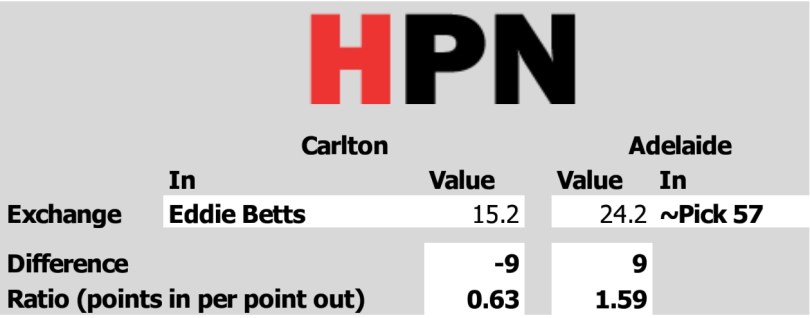Eddie Betts has been one of the most exciting and most beloved players in the league for a while now, and remains one of the more dangerous small forwards in the competition. A pre-season draftee after being overlooked in the national draft, he fairly quickly became a reliable goal-a-game small forward and between 2011 and 2017 he averaged 2.3 goals per game. At his peak from 2015 to 2017 he was a three-time All-Australian.
Note: This article is part of a series using a valuation method called Player Approximate Value (PAV) to evaluate trades for fairness and balance. Elsewhere, you can read much more about the method and theory behind PAV. You can also read about PAPLEY, the projection method used to derive expected future PAVs, which has been revised for 2019.
Despite his age, Betts’ value onfield has held up fairly well, and he’s still been good enough to be a starter in pretty much any team in the comp even without meeting the lofty standards he set as a hugely influential star prior to 2018.
There is still little reason to think his 2019 form wasn’t good enough to be a starter in most teams in the comp, however. The 12.5 PAV of his 2019 season was unsurprisingly mostly up forward, and his 2019 offensive PAV of 9.5 was good for 17th in the comp. The fit at Carlton seems a good one too, at last for next year.
With Curnow, McGovern and Kreuzer having reduced numbers of games and the impressive Harry McKay still on his upswing, Betts gave more value offensively over the year than any individual Carlton player did. Crucially to illustrating Carlton’s priorities this trade period, none of the top offensive contributors at Carlton last year were specialist small forwards, with midfielders Michael Gibbons, Mark Murphy and Patrick Cripps all heavily involved up forward instead. Betts isn’t a solution for Carlton’s next period of contention, but he’s a stopgap and a feelgood move for the club and his intellectual property might prove valuable post-retirement if he sticks around at Lygon Street.
The trade
Betts’ trade value however should be fairly modest, simply because he’s 33 years old in November. PAPLEY, a projection system based on past player data, is predicting him to last basically one more full season before retiring, and to produce about as much value as the career predicted for pick 77.
Generally at this age, more players will retire after next year than not retire (five of the ten players 34 or older retired at the end of this year). However, as long as he keeps going, Betts will probably play reasonably close to how he has in the last two seasons. Players in this age bracket tend necessarily to be good in the first place, and rather than gradually getting worse, they tend to just disappear from the sample completely, reflecting retirement.
Verdict: A notional overpay if Betts only plays the predicted one season, but with a late enough pick that it’s not that important.




